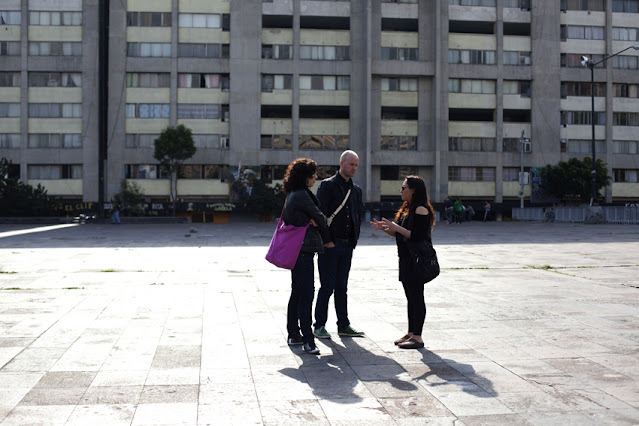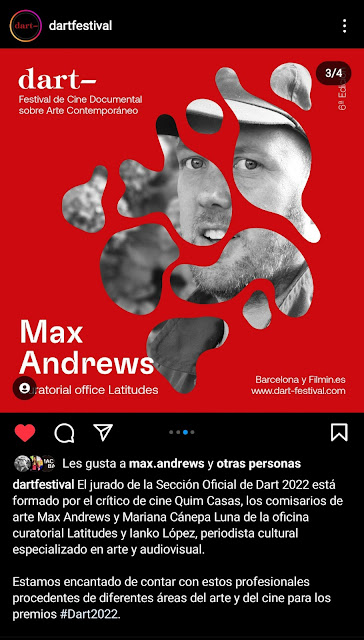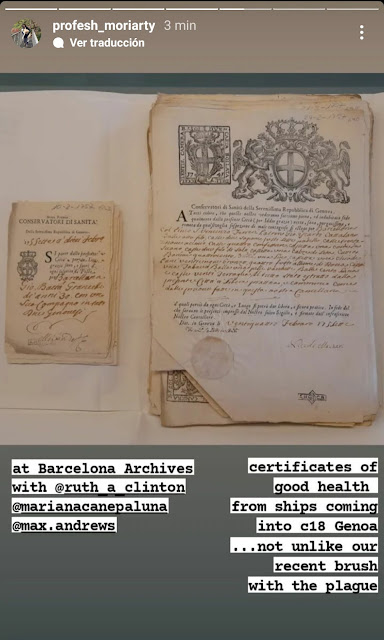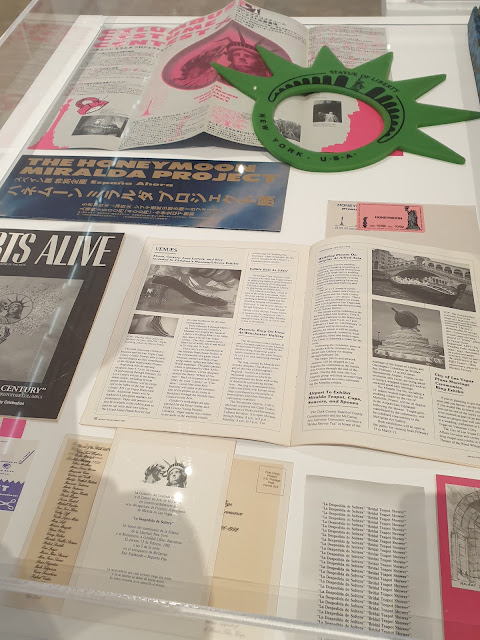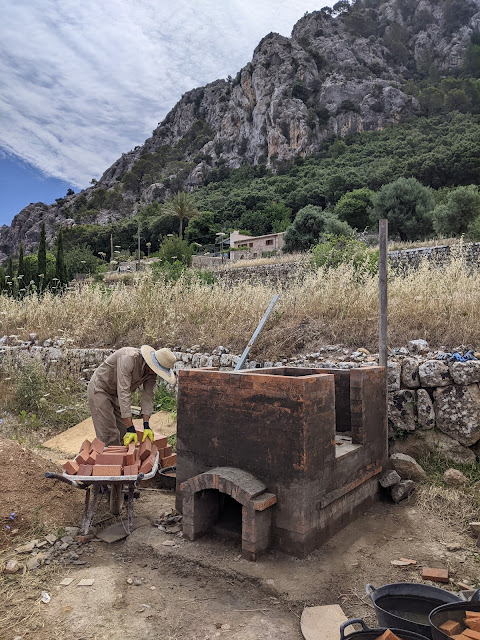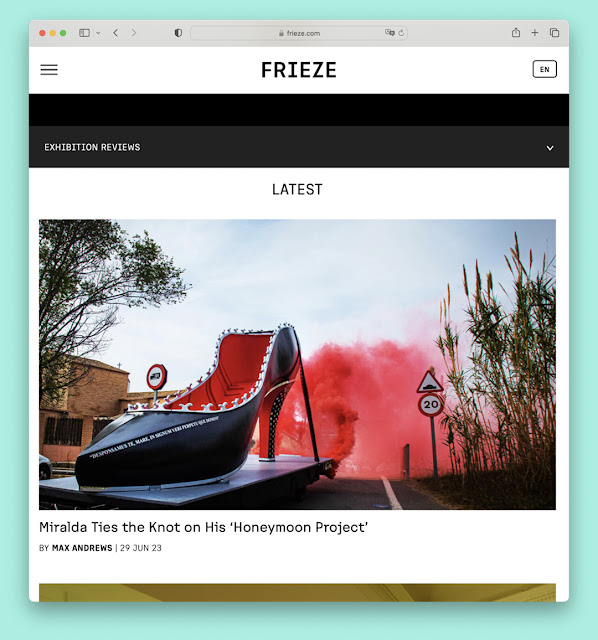Cover Story, May 2025: Ria, Ría: sweet, brackish, or salty Satorre
Fri, May 2 2025NEW
NEW MONTH
NEW MONTHLY COVER STORY
The May 2025 monthly Cover Story “Río, Ría: sweet, brackish, or salty Satorre” is now on our homepage: www.lttds.org (after May, this story will be archived here).
- Archive of Monthly Cover Stories
- Cover Story, April 2025: Wrecking the Floor Tiles, 1 April 2025
- Cover Story, March 2025: “Hello Everyone from the Museo Reina Sofía”, 3 Mar 2025
- Cover Story, February 2025: Bananas, Potatoes, Ria, Río: Jorge Satorre at CA2M, 3 Feb 2025
- Cover Story, January 2025: Folded Forms, 1 January 2025
- Cover Story, December 2024: On the (Critical, Contextual) Rocks, 1 December 2024
- Cover Story, November 2024: Max Andrews on Robert Smithson’s text “Aerial Art” (1969), 1 Nov 2024
- Cover Story, October 2024: Nancy Holt “Ventilation System”, 1 Oct 2024
- Cover Story, September 2024: THE CREST OF A WAVE, 2 Sept 2024
- Cover Story, July-August 2024: Rosa Tharrats, Curtain Call, 1 July 2024
- Cover Story, June 2024: TERENCE GOWER—DIPLOMACY, URBANISM, URANIUM, 3 June 2024
- Cover Story, May 2024: Richard Serra & Anne Garde—Threats of Paradise, 30 Apr 2024
Cover Story, April 2025: Wrecking the Floor Tiles
Tue, Apr 1 2025NEW
NEW MONTH
NEW MONTHLY COVER STORY
The April 2025 monthly Cover Story “Wrecking the Floor Tiles” is now on our homepage: www.lttds.org (after April, this story will be archived here).
- Archive of Monthly Cover Stories
- Cover Story, March 2025: “Hello Everyone from the Museo Reina Sofía”, 3 Mar 2025
- Cover Story, February 2025: Bananas, Potatoes, Ria, Río: Jorge Satorre at CA2M, 3 Feb 2025
- Cover Story, January 2025: Folded Forms, 1 January 2025
- Cover Story, December 2024: On the (Critical, Contextual) Rocks, 1 December 2024
- Cover Story, November 2024: Max Andrews on Robert Smithson’s text “Aerial Art” (1969), 1 Nov 2024
- Cover Story, October 2024: Nancy Holt “Ventilation System”, 1 Oct 2024
- Cover Story, September 2024: THE CREST OF A WAVE, 2 Sept 2024
- Cover Story, July-August 2024: Rosa Tharrats, Curtain Call, 1 July 2024
- Cover Story, June 2024: TERENCE GOWER—DIPLOMACY, URBANISM, URANIUM, 3 June 2024
- Cover Story, May 2024: Richard Serra & Anne Garde—Threats of Paradise, 30 Apr 2024
- Cover Story, April 2024: In Progress–Iratxe Jaio and Klaas van Gorkum, 2 April 2024
- Cover Story, March 2024: Dibbets en Palencia, 4 March 2024
Jorge Satorre’s first monograph, “Río” published by Museo CA2M and Caniche Editorial (2025)
Tue, Feb 11 2025The publication brings together a selection of his solo exhibitions and works from the last fifteen years, arranged in reverse chronological order. It also includes new essays such as “The Weight of the World” by Sean Lynch (artist and curator, Askeaton, Ireland); the conversation “A Matter of Distance” between the artist and Latitudes, the exhibition curators; and the essay “The Virtues of Drawing” by Daniel Garza Usabiaga (Director of the Museo del Palacio de Bellas Artes, Mexico City).
Meticulously designed by the artist and editor Gabriel Pericàs in collaboration with Satorre and coordinated by Belén Benito, the book has been co-published by Museo CA2M and Caniche Editorial in a bilingual Spanish-English edition.
In the words of Caniche Editorial, it is “a book that offers an exhaustive journey through his career and one we believe will be an essential tool for immersing oneself in the work and processes of a pivotal artist.”
Title: Río
Format: 224 pages, 32 × 24 cm, softcover
Price: 30 Euros
ISBN: 978-84-451-4165-6 (CA2M) / 978-84-129787-1-1 (Caniche Editorial)
- Cover Story, November 2022: Jorge Satorre’s Barcelona, 1 Nov 2022
- Opening of the exhibition “Ria” by Jorge Satorre at the Museo CA2M, Móstoles, 27 Jan 2025
- Cover Story, November 2022: Jorge Satorre’s Barcelona, 1 Nov 2022
- Conversación en línea con Jorge Satorre, 22 de septiembre a las 19h UTC, 14 September 2021
- Cover Story, September 2021: Erratic behaviour—Latitudes in conversation with Jorge Satorre, 31 August 2021
- Portscapes project page
- Portscapes photo documentation
- Web of the artist about ‘The Erratic. Measuring Compensation’
- Review of the exhibition "What cannot be used is forgotten" in the May issue of frieze, 29 April 2015
- Publication "Robert Smithson: Art in Continual Movement" (Alauda Publications, 2012) includes an essay by Max Andrews, 28 Mar 2012
- Lecture by Max Andrews "From Spiral to Spime: Robert Smithson, the ecological and the curatorial", 13 March, 2pm, Lecture Theatre 1, Royal College of Art, London, 12 March 2012
- Interview with Erick Beltrán & Jorge Satorre published in 'Atlántica' magazine #52, 13 Feb 2012
- Proyecto producido por Jorge Satorre para 'Portscapes' (2009) expuesto en la exposición colectiva 'Fat Chance to Dream', Maisterravalbuena, Madrid, 29 Mar 2011
- 2009 Video of the making of Jorge Satorre's project
- Portscapes news: Jorge Satorre's billboard on the A15 and Paulien Oltheten’s small exhibition at the visitor centre Futureland and surroundings, 2 October 2009
Cover Story, February 2025: Bananas, Potatoes, Ria, Río: Jorge Satorre at CA2M
Mon, Feb 3 2025NEW
NEW MONTH
NEW MONTHLY COVER STORY
The February 2025 monthly Cover Story “Bananas, Potatoes, Ria, Río: Jorge Satorre at CA2M” is now up on our homepage: www.lttds.org (after February this story will be archived here).
“Jorge Satorre’s “Triplay” (2025) serves as the entrance to his exhibition “Ria”, currently on view at the Museo Centro de Arte Dos de Mayo (CA2M), curated by Latitudes. Two large wooden doors, embedded with metal casts of bananas and potatoes, form this threshold. Everyday objects are laden with both mundane associations and personal significance.” → Continue reading
Cover Stories are published monthly on Latitudes’ homepage, featuring past, present, or forthcoming projects, research, texts, artworks, exhibitions, films, objects, or field trips related to our curatorial projects and activities.
- Archive of Monthly Cover Stories
- Cover Story, January 2025: Folded Forms, 1 January 2025
- Cover Story, December 2024: On the (Critical,
- Contextual) Rocks, 1 December 2024
- Cover Story, November 2024: Max Andrews on Robert Smithson’s text “Aerial Art” (1969), 1 Nov 2024
- Cover Story, October 2024: Nancy Holt “Ventilation System”, 1 Oct 2024
- Cover Story, September 2024: THE CREST OF A WAVE, 2 Sept 2024
- Cover Story, July-August 2024: Rosa Tharrats, Curtain Call, 1 July 2024
- Cover Story, June 2024: TERENCE GOWER—DIPLOMACY, URBANISM, URANIUM, 3 June 2024
- Cover Story, May 2024: Richard Serra & Anne Garde—Threats of Paradise, 30 Apr 2024
- Cover Story, April 2024: In Progress–Iratxe Jaio and Klaas van Gorkum, 2 April 2024
- Cover Story, March 2024: Dibbets en Palencia, 4 March 2024
- Cover Story, February 2024: Climate Conscious Travel to ARCOmadrid, 1 February 2024
Opening of the exhibition “Ria” by Jorge Satorre at the Museo CA2M, Móstoles
Mon, Jan 27 2025In 2005, Max Andrews (1975 Bath) and Mariana Cánepa Luna (1977 Montevideo) founded Latitudes, a curatorial office based in Barcelona that works internationally across contemporary art practices.
- Cover Story, November 2022: Jorge Satorre’s Barcelona, 1 Nov 2022
- Conversación en línea con Jorge Satorre, 22 de septiembre a las 19h UTC, 14 September 2021
- Cover Story, September 2021: Erratic behaviour—Latitudes in conversation with Jorge Satorre, 31 August 2021
- Portscapes project page
- Portscapes photo documentation
- Web of the artist about ‘The Erratic. Measuring Compensation’
- Review of the exhibition "What cannot be used is forgotten" in the May issue of frieze, 29 April 2015
- Publication "Robert Smithson: Art in Continual Movement" (Alauda Publications, 2012) includes an essay by Max Andrews, 28 Mar 2012
- Lecture by Max Andrews "From Spiral to Spime: Robert Smithson, the ecological and the curatorial", 13 March, 2pm, Lecture Theatre 1, Royal College of Art, London, 12 March 2012
- Interview with Erick Beltrán & Jorge Satorre published in 'Atlántica' magazine #52, 13 Feb 2012
- Proyecto producido por Jorge Satorre para 'Portscapes' (2009) expuesto en la exposición colectiva 'Fat Chance to Dream', Maisterravalbuena, Madrid, 29 Mar 2011
- 2009 Video of the making of Jorge Satorre's project
- Portscapes news: Jorge Satorre's billboard on the A15 and Paulien Oltheten’s small exhibition at the visitor centre Futureland and surroundings, 2 October 2009
SAVE THE DATE: 1 February 2025 opening of Jorge Satorre’s exhibition “Ria” at the Museo Centro de Arte Dos de Mayo, Móstoles (Madrid)
Wed, Jan 8 2025- Cover Story, November 2022: Jorge Satorre’s Barcelona, 1 Nov 2022
- Conversación en línea con Jorge Satorre, 22 de septiembre a las 19h UTC, 14 September 2021
- Cover Story, September 2021: Erratic behaviour—Latitudes in conversation with Jorge Satorre, 31 August 2021
- Portscapes project page
- Portscapes photo documentation
- Web of the artist about ‘The Erratic. Measuring Compensation’
- Review of the exhibition "What cannot be used is forgotten" in the May issue of frieze, 29 April 2015
- Publication "Robert Smithson: Art in Continual Movement" (Alauda Publications, 2012) includes an essay by Max Andrews, 28 Mar 2012
- Lecture by Max Andrews "From Spiral to Spime: Robert Smithson, the ecological and the curatorial", 13 March, 2pm, Lecture Theatre 1, Royal College of Art, London, 12 March 2012
- Interview with Erick Beltrán & Jorge Satorre published in 'Atlántica' magazine #52, 13 Feb 2012
- Proyecto producido por Jorge Satorre para 'Portscapes' (2009) expuesto en la exposición colectiva 'Fat Chance to Dream', Maisterravalbuena, Madrid, 29 Mar 2011
- 2009 Video of the making of Jorge Satorre's project
- Portscapes news: Jorge Satorre's billboard on the A15 and Paulien Oltheten’s small exhibition at the visitor centre Futureland and surroundings, 2 October 2009
Latitudes’ “out of office” 2023-24 season
Mon, Jul 29 20249 April 2024: We are pleased to be on the second cohort of 125 Active Members announced by Gallery Climate Coalition. As part of Latitudes’ ongoing environmental commitment, and as Committee members of GCC Spain, we submitted our individual 2023 carbon footprint calculations to Gallery Climate Coalition (GCC) to renew our status for the second year running. We are committed to reducing our carbon footprint in line with the United Nations Sustainable Development Goal 13 “Climate Action”, as well as the Paris Agreement to reduce global carbon emissions by 50% by 2030 and as custodians of the Reduce Art Flights website, a campaign devised by artist Gustav Metzger in 2007.
A press conference in early 2025 will announce the 2024 acquisitions—including works of contemporary art, photography, cultural artefacts, comics and illustration, postwar art, and the second avant-garde—publicly. Behind this forthcoming announcement are long days reviewing the 434 applications received, followed by 8 online sessions lasting 3 to 4 hours each debating proposals alongside the members of this year’s Committee.
- Latitudes’ writing – reviews, profiles, interviews, essays, features, and opinions.
- Latitudes’ "out of office" 2022–23 season, 25 July 2023
- Latitudes’ "out of office" 2021–22 season, 1 August 2022
- Latitudes’ "out of office" 2020–21 season, 2 August 2021
- Latitudes’ "out of office" 2019–20 season, 3 August 2020
- Latitudes’ "out of office" 2018–19 season, 1 August 2019
- Latitudes' "out of office" 2017–18 season, 2 August 2018
- Latitudes "out of office" 2016–17 season, 1 August 2017
- Latitudes' "out of office" 2015–16 season, 1 August 2016
- Latitudes' "out of office" 2014–15 season, 7 August 2015
- Latitudes' "out of office" 2013–14 season, 31 July 2014
- Latitudes' "out of office" 2012–13 season, 31 July 2013
- Latitudes' "out of office" 2011–12 season, 31 July 2012
- Latitudes' "out of office" 2010–11 season, 1 August 2011
- Latitudes' "out of office" 2009–10 season, 30 July 2010
- Latitudes' "out of office" 2008–9 season, 30 July 2009
Latitudes’ "out of office" 2022–23 season
Tue, Jul 25 2023Premio Laie DART 2022 de la Crítica (Laie DART 2022 Critics Award): “The Melt Goes On Forever: The Art and Times of David Hammons” (EEUU, 2021). Directed by cultural journalist Judd Tully and filmmaker Harold Crooks, the documentary focuses on the elusive figure of African-American artist David Hammons, whose artistic practice spans six decades and foregrounds social criticism in the United States.
16–18 May 2023: Work trip to València to visit Antoni Miralda’s exhibition “Miralda. Honeymoon: Unclassified” at Bombas Gens, curated by its artistic director Sandra Guimarães. The show centres on his “Honeymoon Project” (1986-1992), a series of intercontinental ceremonial actions around the romance and subsequent marriage between two historical monuments: that of Christopher Columbus, in the port of Barcelona, and the Statue of Liberty, in New York Bay. Max of Latitudes will review it for frieze’s October issue (online in June).
- Latitudes’ writing – exhibition reviews, artist profiles, interviews, catalogue essays, features, and opinions.
- Latitudes’ "out of office" 2021–22 season, 1 August 2022
- Latitudes’ "out of office" 2020–21 season, 2 August 2021
- Latitudes’ "out of office" 2019–20 season, 3 August 2020
- Latitudes’ "out of office" 2018–19 season, 1 August 2019
- Latitudes' "out of office" 2017–18 season, 2 August 2018
- Latitudes "out of office" 2016–17 season, 1 August 2017
- Latitudes' "out of office" 2015–16 season, 1 August 2016
- Latitudes' "out of office" 2014–15 season, 7 August 2015
- Latitudes' "out of office" 2013–14 season, 31 July 2014
- Latitudes' "out of office" 2012–13 season, 31 July 2013
- Latitudes' "out of office" 2011–12 season, 31 July 2012
- Latitudes' "out of office" 2010–11 season, 1 August 2011
- Latitudes' "out of office" 2009–10 season, 30 July 2010
- Latitudes' "out of office" 2008–9 season, 30 July 2009
2022 in 11 monthly Cover Stories
Tue, Dec 27 2022→ RELATED CONTENT:
- 2019 in 10 monthly Cover Stories, 23 Dec 2019
- 2020 in 11 monthly Cover Stories, 28 Dec 2020
- 2021 in 11 monthly Cover Stories, 31 Dec 2021
Cover Story, November 2022: Jorge Satorre’s Barcelona
Tue, Nov 1 2022The November 2022 monthly Cover Story “Jorge Satorre’s Barcelona” is now up on our homepage: www.lttds.org
“Below the Tibidabo Amusement Park, just where the BV-1418 and BP-1417 roads meet, there are some stairs that go up into the forest. Climbing them, a few meters up on the right, we will find a large stone hidden among the trees.” Continue reading
After November 2022 this story will be archived here.
Cover Stories are published on a monthly basis on Latitudes’ homepage featuring past, present or forthcoming projects, research, texts, artworks, exhibitions, films, objects or field trips related to our curatorial projects and activities.
- Archive of Monthly Cover Stories
- Cover Story, September 2021: Erratic behaviour—Latitudes in conversation with Jorge Satorre, 31 August 2021
- Web of the artist about “The Erratic. Measuring Compensation”
- Publication "Robert Smithson: Art in Continual Movement” (Alauda Publications, 2012) includes an essay by Max Andrews, 28 Mar 2012
- Lecture by Max Andrews “From Spiral to Spime: Robert Smithson, the ecological and the curatorial”, 13 March, 2pm, Lecture Theatre 1, Royal College of Art, London, 12 March 2012
- Interview with Erick Beltrán & Jorge Satorre published in “Atlántica” magazine #52, 13 Feb 2012
- Proyecto producido por Jorge Satorre para “Portscapes” (2009) expuesto en la exposición colectiva “Fat Chance to Dream”, Maisterravalbuena, Madrid, 29 Mar 2011
- 2009 Video of the making of Jorge Satorre's project
- Portscapes news: Jorge Satorre's billboard on the A15 and Paulien Oltheten's small exhibition at the visitor centre Futureland and surroundings, 2 October 2009


































































































